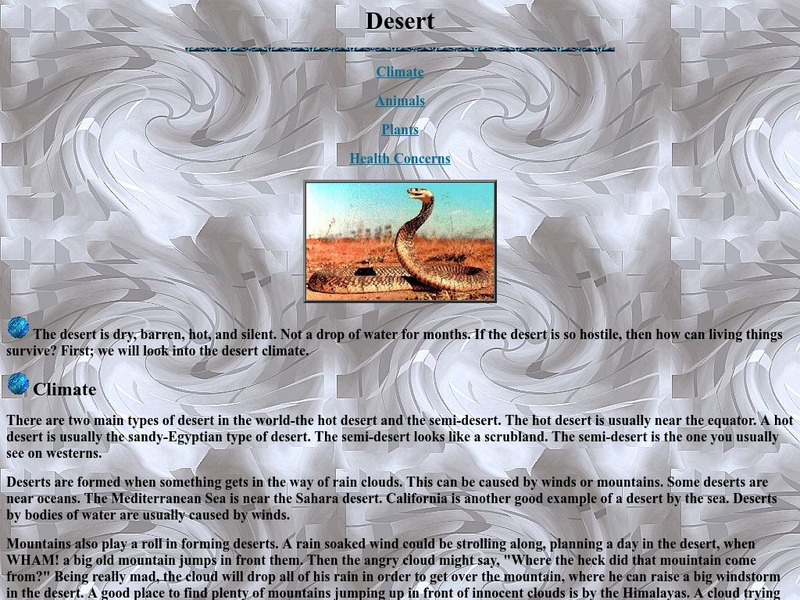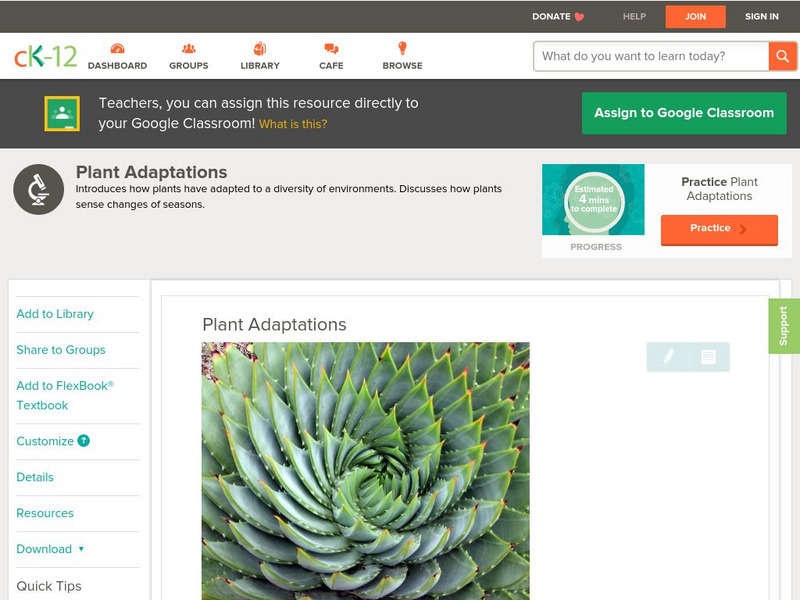Other
Thurston High School: Sharryl Lattion and Melissa Femrite: Biomes: Desert
Written for younger readers, this article reveals facts about animals and plants as well as health concerns for people in the desert environment.
Utah Education Network
Uen: Trb 4:5 Investigation 5 Desert Dynamics
Fourth graders will understand how plants and animals adapt to their environment.
Cornell Lab of Ornithology
Habitat Network: The Special Nature of Arid Landscapes
Find out how to make the most of a desert environment in order to foster a wide array of species diversity.
Other
Greatest Places: Namib
Explore the Namib Desert and learn about its location, the Skeleton Coast, mirages, and general information about this home to the highest sand dunes in the world.
Other
Ancient Mysteries: Gobi Desert Mysteries
This site details information about the mysteries of the Gobi Desert, an area actually comprised more of mountains than desert. This site has a map of the Gobi area, photos of the Gobi, as well as links to information about ancient...
The History Cat
The History Cat: Geography: Environment: The Incredible Shrinking Sea
Describes the economic policies of the Soviet Union that turned the Aral Sea, once the world's largest body of fresh water, into two smaller seas and desert. Includes a video. [10:29]
National Geographic Kids
National Geographic Kids: Animals: Bactrian Camel
Great site for youngers researching the Bactrian camel. Video clip, photos, and easy to read facts about habitat, young, enemies, food, adaptation to environment, and humps!
Utah Education Network
Uen: Trb 4:5 Investigation 1 Wetlands, Forests & Deserts
Learn about surface terrain and how plants and animals are affected by the temperatures and precipitation.
Curated OER
Bureau of Land Management: Alaska's Cold Desert
Learn about the Arctic tundra biome of Alaska. A discussion of its characteristics, and the animals and the plants that live there.
The History Cat
The History Cat: Geography: Environment: Fighting Desertification
Lists reasons we should be concerned about desertification and discusses how the Sahel region south of the Sahara Desert is becoming desertified.
Extreme Science
Extreme Science: Hottest Place on Earth: Lut Desert, Iran
A description of the climate in Lut Desert, Iran, which was documented as having repeatedly reached the highest temperatures of anywhere on Earth. Includes explanation of how extreme heat occurs.
American Forum for Global Education
American Forum for Global Education: Challenge of the Desert
This elementary exploration of interdependence from the American Forum for Global Education touches on language arts, social studies, and science. Students understand the connection between themselves and their natural environment.
CK-12 Foundation
Ck 12: Biology: Plant Adaptations
[Free Registration/Login may be required to access all resource tools.] An overview of how plants have adapated to their environments.
Curated OER
Science Kids: Science Images: Desert Trees
This photo shows a number of desert trees that are found living in the hot, harsh, desert environment.
Curated OER
Wikipedia: National Historic Landmarks in Arizona: Desert Laboratory
Founded in 1903 to study plant adaptation to an arid desert environment with long term experiments, this laboratory contributed significantly to the formation of Ecology as a science. Part of the University of Arizona.
Arizona State University
Geo Literacy: The Desert Is Theirs: Adapting to Our Environment
The focus of this 3-part lesson is how the environment affects the human lifestyle. After reading the book, The Desert is Theirs by Byrd Baylor, students will understand how animals and humans have adapted to their environments in both...
Other
California's Native People, Desert Interior
This site has information about the settlement patterns of the Native People of California based on the location and availability of resources.
Curated OER
Cbc: Human Odyssey: A World of Extremes
Immerse yourself in the nomadic worlds of people who live in extreme environments. The Badjao are sea nomads in the Philippines who still live a hunter-gatherer existence but they do it on water. The Bushmen are desert nomads living in...
Other
California State Parks: Paleontology
The California State Parks present an excellent unit to local geology of Borrego Badlands to Salton Trough. Through lessons plans, power point presentations, and a videoconference students will take a closer look into fossils and the...
Country Studies US
Country Studies: Saudi Arabia: Geography
Saudi Arabia's geography as it relates to its neighbors is explained in this Country Studies article from the Library of Congress. See how difficult it is to determine country borders in a desert area.
Country Studies US
Country Studies: Saudi Arabia: Topography and Natural Regions
This comprehensive article on the topography of Saudi Arabia is from the Country Studies section of the Library of Congress. Read about the north end of the Great Rift Valley, the massive deserts, and the deep aquifers on the Arabian...
The Association of the British Pharmaceutical Industry
Abpi: Human and Animal Habitats
An interactive learning game where students answer whether or not certain environments would be suitable for different animals. Printable worksheets are available for review at the end of the activity.
Encyclopedia of Earth
Encyclopedia of Earth: Arctic Climate Impact Assessment
An extensive research report on climate change in the Arctic and the impact this is having on the environment, flora and fauna, and indigenous peoples. (Updated: December 20, 2010)
Other
Ahlul Bayt Digital Islamic Library Project: The Geography of Arabia
Synopsis of the geography of the Arabian Peninsula - the heart of Islam. Describes the area as a bleak and desolate desert, but also very photogenic. Includes a brief description of the various political divisions located on the Arabian...
















